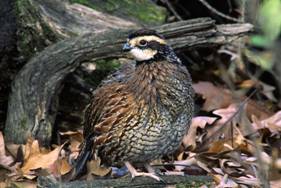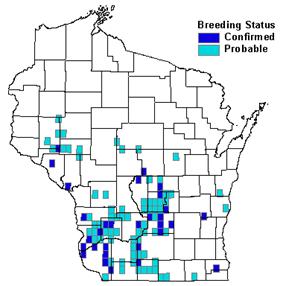

Status/Protection
- Global Rank: G5 Key to global and state ranks
- State Rank: S3B
- WBCI Priority: SGCN, PIF, State Special Concern
Population Information
The Federal BBS information can be obtained at http://www.mbr-pwrc.usgs.gov/bbs/bbs.html by clicking on Trend Estimates and selecting the species in question. All estimates are for time period (1966-2005).
*Note: There are important deficiencies with these data. These results may be compromised by small sample size, low relative abundance on survey route, imprecise trends, and/or missing data. Caution should be used when evaluating this trend.
- Federal Breeding Bird Survey: significant decline
- Federal Breeding Bird Survey (WI): non-significant decline
- Federal Breeding Bird Survey (BCR 23): significant decline
- Federal Breeding Bird Survey (BCR 12): non-significant decline*
- WSO Checklist Project: stable (1983-2007)
- Wisconsin Bobwhite Survey: significant decline (1949-2005)
Life History
- Breeding Range: Throughout eastern U.S west to the Great Plains (Brennan 1999).
- Breeding Habitat: Idle Cool-Season Grasses, Idle Warm-season Grasses, Fallow Field, Hay, Pasture, Grassland-shrub, Dry-mesic Prairie, Oak Opening, Sand Barrens, Dry Prairie.
- Nest: Ground, scrape lined with grasses and dead vegetation; often partially covered with arched, standing vegetation.
- Nesting Dates: EGGS: early May to July.
- Foraging: Ground glean.
- Migrant Status: Permanent Resident.
- Habitat use during Migration: N/A
- Arrival Dates: N/A
- Departure Dates: N/A
- Winter Range: Same as breeding range.
- Winter Habitat: Same as breeding habitat. Some woody cover is important.
Habitat Selection
Northern Bobwhites use a variety of early successional and open habitats during the different stages of their life cycle. Typical habitats in Wisconsin include idle grasslands, fallow fields (“old fields”), hayfields, pastures, dry-mesic prairie, and oak savannah. Row crops and small grains also are used for foraging throughout the year, but especially in winter. Shrubs, brush piles, and hedgerows are used for hiding and roosting (Sample and Mossman 1997). Nests are placed on the ground, usually within 15-20 meters of openings such as fields or roads (Brennan 1999).
Habitat Availability
Existing parcels of native grasslands in the state are few, and those remaining are vulnerable to fragmentation, row crop conversion, urban development, and forest succession. Pastures, fallow fields, and hayfields are more common, but are still subject to the same threats. Hayfields also may act as ecological sinks if mowed early in the breeding season (Sample and Mossman 1997). The intensification of agriculture has reduced the suitability of much farmland through the removal of hedgerows and fence lines. Furthermore, the use of pesticides on agricultural lands limits prey availability (Brennan 1999).
Population Concerns
Northern Bobwhites were abundant historically in southern and central Wisconsin. However, intensive market hunting in the late 1800s and subsequent changes in agricultural practices have resulted in dramatic declines (Robbins 1991). Severe winters also may contribute to declines in the state (Knutson et al. 2001). Breeding Bird Survey data suggest significant declines range-wide (Sauer et al. 2005) and annual counts conducted by the Department of Natural Resources seem to corroborate this trend in Wisconsin (Kitchell 2005). Wisconsin Breeding Bird Atlas efforts documented breeding activity in just 12% of the surveyed quads (Duerksen 2006). Northern Bobwhites are now concentrated in southwestern Wisconsin, with scattered populations in the central and southeastern regions of the state. Although they are still hunted, harvest levels remain lower than historic numbers (<8000 birds/year) (Robbins 1991).
Recommended Management
A combination of grassland, woody or brushy cover, and agricultural land are necessary to maintain quail on the landscape. Northern Bobwhites benefit from a variety of habitat management practices aimed at restoring grassland cover for nesting and brood-rearing (Sample and Mossman 1997, Brennan 1999) and have shown positive responses to USDA conservation programs (Burger et al. 2006). However, additional emphasis must be placed on landscape scale management, instead of the traditional fine scale habitat management deemed necessary for quail (Williams et al. 2004a). Northern Bobwhites are a resident gamebird with limited dispersal capabilities and are especially impacted by habitat fragmentation (Guthery et al. 2000). Northern Bobwhite coveys that exist in isolated habitat patches are susceptible to local extinction due to a variety of factors (Williams et al. 2004b). Linking habitat patches or providing the ability for dispersal between patches is needed to ensure the long-term viability of Northern Bobwhite populations (Guthery et al. 2000).
Research Needs
Northern Bobwhites are one of the best-studied gamebirds in North America (Brennan 1991). However, there is little known about how habitat fragmentation and landscape level factors affect this species. Additional research examining how this species is impacted by the USDA conservation programs is needed, especially as the amount of available habitat fluctuates with changes in commodity agricultural production. Additional research that investigates the relationships among harvest mortality, dispersal, and metapopulation dynamics is needed (Williams et al. 2004b). Harvest management systems that incorporate results from these studies, i.e., adaptive management, will help balance recreational hunting opportunities with the long-term viability of this species.
Information Sources
- Cornell Lab of Ornithology species account: http://www.birds.cornell.edu/AllAboutBirds/BirdGuide/Northern_Bobwhite_dtl.html
- North American Breeding Bird Survey:
http://www.mbr-pwrc.usgs.gov/bbs/bbs.html - Temple S. A., J. R. Cary, and R. Rolley. 1997. Wisconsin Birds; a Seasonal and Geographical Guide.
- Wisconsin Society of Ornithology and Wisconsin Department of Natural Resources, Madison, WI.
- Wisconsin Breeding Bird Atlas: http://www.uwgb.edu/birds/wbba/
- David Sample, Grassland Community Ecologist, Wisconsin DNR - 608-221-6351.
References
- Brennan, L.A. 1991. How can we reverse the Northern Bobwhite population decline? Wildlife Society Bulletin 19: 544-555.
- Brennan, L.A. 1999. Northern Bobwhite (Colinus virginianus). In the Birds of North America, No. 397 (A. Poole and F. Gill, eds.). The Birds of North America, Inc., Philadelphia, PA.
- Burger, L.W., Jr., W.D. McKenzie, R. Thackston, and S. Demaso. 2006. The role of Farm Policy in achieving large scale conservation: bobwhite and buffers. Wildlife Society Bulletin 34: 986-993.
- Duerksen, B. 2006. Northern Bobwhite. In Atlas of the Breeding Birds of Wisconsin. (N.J. Cutright, B.R. Harriman, and R.W. Howe, eds.) The Wisconsin Society for Ornithology, Inc. 602pp.
- Guthery, F.H., M.J. Peterson, and R.R. George. 2000. Viability of northern bobwhite populations. Journal of Wildlife Management 64: 646-662.
- Kabat, C., D.R. Thompson, and R.L. Hine, eds. Wisconsin quail 1834-1962: population dynamics and habitat management. Wisconsin Dept. of Natural Resources Technical Bulletin Number 30. Madison, Wisconsin.
- Kitchell, J. 2005. Regional Bobwhite Quail and Cottontail Rabbit Survey. Wisconsin Department of Natural Resources Technical Report.
- Knutson, M.G., G. Butcher, J. Fitzgerald, and J. Shieldcastle. 2001. Partners in Flight Bird Conservation Plan for The Upper Great Lakes Plain (Physiographic Area 16). USGS Upper Midwest Environmental Sciences Center in cooperation with Partners in Flight. La Crosse, WI.
- Robbins, S.D., Jr. 1991. Wisconsin Birdlife: Population and distribution past and present. Madison, WI: Univ. Wisconsin Press.
- Sample, D. and M. Mossman. 1997. Managing Habitat for Grassland Birds: A Guide for Wisconsin. Wisconsin Department of Natural Resources: Madison, WI.
- Sauer, J.R., J.E. Hines, and J. Fallon. 2005. The North American Breeding Bird Survey, Results and Analysis 1966 - 2005. Version 6.2.2006. USGS Patuxent Wildlife ResearchCenter, Laurel, MD.
- Williams, C.K., F.H. Guthery, R.D. Applegate, and M. Peterson. 2004a. Rescaling northern bobwhite management for the 21st century. Wildlife Society Bulletin 32: 861-869.
- Williams, C.K., R.S. Lutz, and R.D. Applegate. 2004b. Winter survival and additive harvest in Kansas northern bobwhite coveys. Journal of Wildlife Management 68: 94-100.
Contact Information
- Compiler: Jenny Herrmann, mherrmann4@wi.rr.com
- Editor: Tom Thrall, tthrall2@yahoo.com | Scott Hull, Scott.Hull@Wisconsin.gov | Kim Kreitinger, K.Kreitinger@gmail.com
